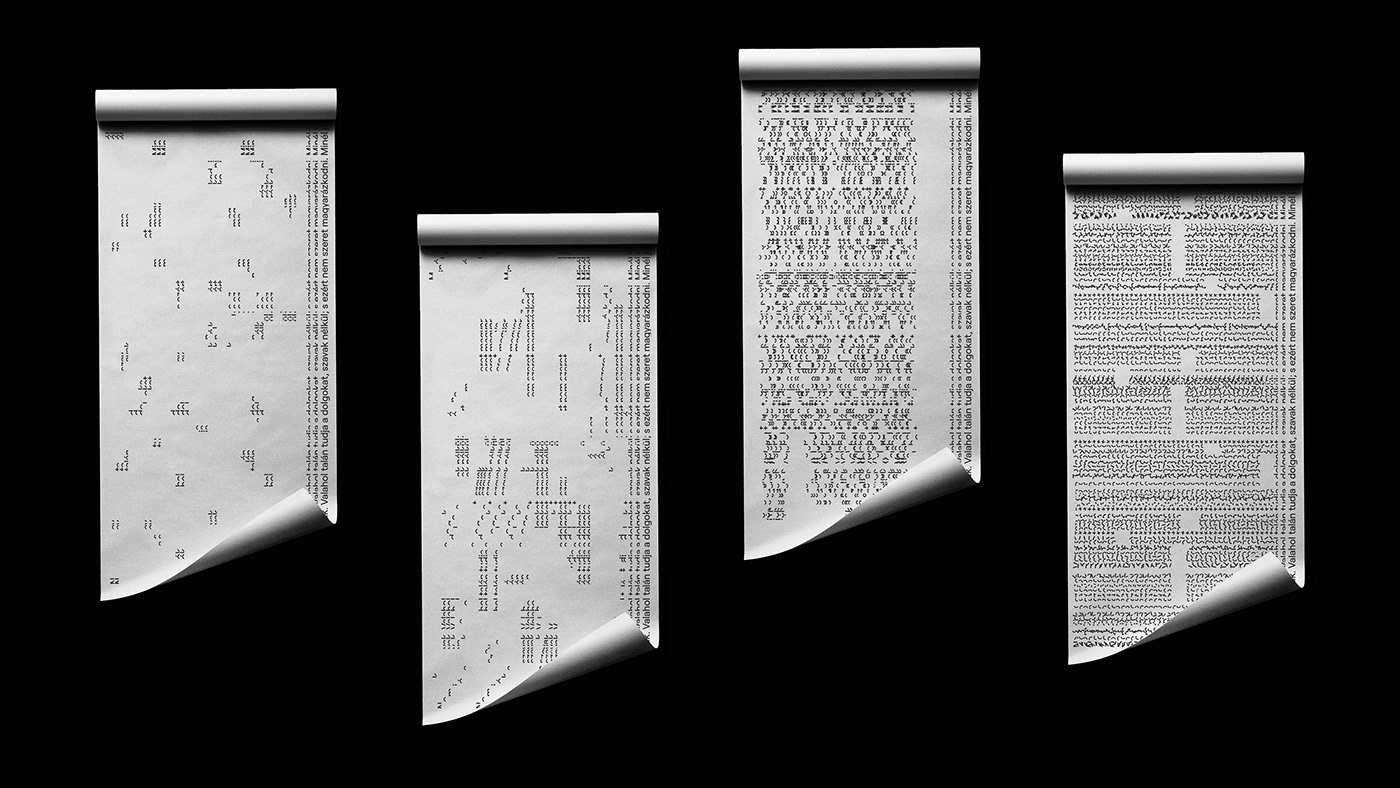
Silēns | Experimental Notation System
• conceptual design
Silēns is an experimental typography project that reinterprets the relationship between text, image, and music. I have developed an individual system that presents language (writing, text) in an unconventional form. In this process, the text goes through a double translation: first into a visual medium through fragmented typography, and then the resulting output is placed into an auditory medium. The process aims to detach from writing as a familiar medium of communication, and from the linguistic nature of writing. It draws on the visuality of the text, the essential relationship between language and sound, and the code-like quality of languages and communication signs.
The conceptual base of the project is the process of reading and the basic properties of letters. If the lower half of a text line is covered, the text can be read to the same extent as if it were seen as a whole, because the recognisability of the letters is located in the upper half of the letters, without affecting the readability of the text. With this idea in mind, I have broken up a text by creating visual compositions using only the upper half of the letters. I have placed the upper parts of the letters in a system, above the original text, in different compositions, emphasising the visual nature of the text and writing. I then attributed sounds to the resulting images by treating the composition as a music score: each node containing letters was marked with graphic symbol. The information of the graphic notation was then manually transferred into a sound editing program based on an individually designed coordinate system. The coordinate system is based on two octaves (vertical) and 15 beats (horizontal). For each image, I added several sound effects to reflect the mood of the composition.
The resulting melodies are entirely generative: they reproduce the exact information of the graphic notation based on the coordinate system that was placed on the letter compositions in an auditory medium. Although the generated soundtracks are derived from a single basic text, they evolve into different melodies through their different visual interpretations. In this way, the concept refers not only to text and language but also to the subjectiveness of human perception and the sensory experience of our environment.
The text used is a quote from a famous Hungarian novel, School at the Frontier by Géza Ottlik. Translation of the quote:
"Words are not right. Perhaps he knows things without words on some level, and that's why he doesn't like explaining himself. The more the words fade, the more the truth densifies; and the final meaning is in the realm of silence, the only place it can be contained."
Project consultants: Balázs Vargha, István Nagy
The project was awarded the Stefan Lengyel Scholarship of Excellence in 2023 at the Moholy-Nagy University of Art and Design.
This project has been featured in:
This project has been featured in:
• Slanted Magazine #40—Experimental Type 2.0 [link]
• IDEEC (International Design Education Expo and Conference) Catalogue [link]





Installation concept, in which the transfer of information into new media could be experienced. The installation takes place in two superimposed spaces. The first space presents the whole text, where it is still readable, together with the decomposition of the text and the visual compositions. In the interior space, an auditory transcription of the text is experienced. Variations of soundtracks are played from loudspeakers placed at different points in space, with different starting times, tempos, and volumes. Depending on the position of the visitor in this space, the installation creates individual auditory content for each visitor. The primary role of the installation is to present the double transcoding of text (language) into a new medium (writing - image - sound) and to present the same information from a new perspective with an emphasis on the subjectivity of the sensory experience.
The varied combination and parallel playback of the resulting soundtracks lead to unique results. The differences between the melodies (rhythm, timbre, effect, etc.) and the controllable factors (loudness, tempo, position of the soundtracks in relation to each other, etc.) played randomly at the same time can lead to interesting, sometimes dissonant, interwoven sounds. Their random playback supports personal experience and subjective interpretation.



Project featured in Slanted Magazine #40—Experimental Type 2.0







